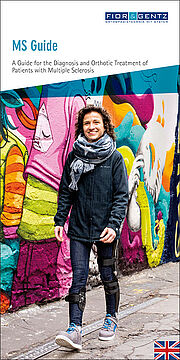Why an Orthosis Helps People with Multiple Sclerosis
Multiple sclerosis (MS) is also known as the disease with a thousand faces because it affects each patient differently.
People affected by multiple sclerosis may develop gait impairments. These occur when individual muscles in one or both legs are affected by paralysis or spasticity. Depending on the severity and location of the MS lesion in the central nervous system, the paralysis can develop to a greater or lesser extent.
A typical symptom is muscular or cognitive exhaustion, known as fatigue. Depending on how the fatigue manifests itself, the gait impairment can be more or less pronounced.

A s the gait impairment increases, so does the risk of falling. An orthosis as a medical device can make everyday life easier. Equipped with individual functional elements, which are determined by configuration using the Orthosis Configurator, it helps the patient to stand and walk safely. Thanks to the orthosis, the risk of tripping and falling can also be reduced.
Patients with MS who are treated with an orthosis share their experiences.
Click here to go to the experience reports.
General Information on Multiple Sclerosis
What Is Multiple Sclerosis?
MS involves a malfunction of the immune system in which the protective layer of the axons is attacked and damaged. Due to an inflammatory reaction and scarring of the nerve tissue in these areas, the transmission of stimuli to the muscle or organs is disturbed.
What Are the Symptoms of Multiple Sclerosis?
MS patients can suffer from a variety of symptoms (clinical pictures). The symptoms, which often occur in episodes, are very individual.
The beginning of an MS disease is usually characterised by motor impairments, visual or sensory disturbances, which manifest themselves throughout the course of the disease. In the advanced stages, the reduced strength of various muscles and spasticity have a negative effect on the ability to walk. Additionally, articulation disorder and bladder dysfunction, cognitive disorders and depression can severely limit the quality of life.
How Can Multiple Sclerosis Be Treated?
Despite intensive research, no cure for MS is yet in sight. However, the intensity and frequency of relapses as well as the progression of the disease can be reduced through medication. In addition, the various symptoms can be controlled or reduced through medication, physiotherapy, occupational therapy or psychotherapy, as well as through the treatment with an orthosis, so that a relatively comfortable life is possible.
Where Can I Find Out More about Multiple Sclerosis and Orthoses?
Our MS Guide contains a concept for the physical examination and treatment of patients with multiple sclerosis with an orthosis. The physical examination presented takes into account the disease-specific changes in gait with a focus on fatigue. Furthermore, with the help of physiotherapeutic exercises, it is demonstrated that qualified physiotherapy and an orthosis with dynamic functional elements complement each other perfectly.
You can download the MS Guide free of charge here. Upon request, we will gladly send you a printed copy. Please contact our In-house Customer Service at info(at)fior-gentz.de or +49 4131 24445-0.
You will find an overview of the different system joints in the knee and ankle area here. The most important functions of the respective system joint are explained in the corresponding product description.
In our User Stories and Videos you get to know patients who are already being treated with an orthosis. You can find the section on patients with multiple sclerosis here.

